Do Good Design
Do Good Design: How Designers Can Change The World is a book by Canadian designer David B. Berman, with a foreword by Erik Spiekermann, published by Peachpit Press in January 2009. The book was co-published by AIGA, the world's largest-membership national design organization, as part of the AIGA Press / New Riders cooperation.
 Cover of English edition | |
| Author | David B. Berman |
|---|---|
| Country | Canada |
| Language | English |
| Subject | Marketing |
| Genre | Non-fiction |
| Publisher | Pearson Education (first edition), Peachpit Press (imprint)/New Riders/AIGA Press |
Publication date | January 2009 |
| Media type | Print (paperback) |
| Pages | 192 (first edition) |
| ISBN | 978-0-321-57320-9 |
| OCLC | 227921823 |
| LC Class | HF5413 .B47 2009 |
Book
The book focuses on graphic design, branding, and social responsibility, and often makes connections with environmentalism. It is written for designers, for those who buy design, and for those who consume design. It alerts designers to the role they play in persuading audiences with their invented needs. Berman pays special attention to the effect of design in the developing world, the deeds and misdeeds of the Coca-Cola Corporation, and women in advertising. Some ideas in Berman's book derive from those of Ken Garland, author of the First Things First manifesto in the 1960s. Garland was the first person to take the Do Good Pledge on the book's Web site.
The book is divided into three sections, ending with a call for all professionals to sign the online Do Good Pledge, which has been signed by notable designers, including Ken Garland.
Reception
The book has been adopted in colleges and universities as a textbook or required reading for students in social responsibility, including Virginia Commonwealth University,[1] whose design program has been rated number one amongst U.S. public universities by U.S. News & World Report.[2] Other schools using this book as a textbook: Algonquin College, Ottawa, ON, Canada; California Baptist University, Riverside, CA, USA; Colorado State University, Boulder, CO, USA; Georgian College, Barrie, ON, Canada; Izmir University of Economics, Izmir, Turkey; Kingston University, London, UK; Massachusetts College of Art And Design, Boston, MA, USA; Ohio Dominican University, Ohio, USA; Seneca College, Toronto, ON, Canada; Youngstown State University, Youngstown, Ohio, USA;
Editions
- Chinese language edition [3] official release: Beijing, October 27, 2009 at World Design Congress, with foreword by Min Wang (head of graphic design Beijing Olympics, chief of design at Chinese Academy of Fine Arts).
- Russian language edition released January 2010.
- Korean language edition released July 2010.
- Indonesian language edition released December 2010.
- Braille edition published in Jakarta (2010)
- 2013 English edition launched April 22, 2013 (Earth Day) with updated content, and printed on 100% post-consumer materials on Mohawk Papers, under FSC stewardship.
- Spanish language edition released July 2015.
See also
References
- "Another Limited Rebellion". Retrieved 2009-03-21.
- "Graphic Design School: Top Ranked Graphic Design Program - Richmond, VA". Retrieved 2009-03-21.
- Chinese language edition